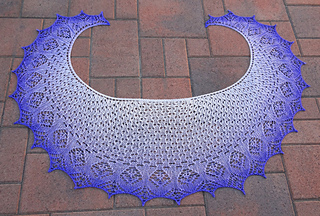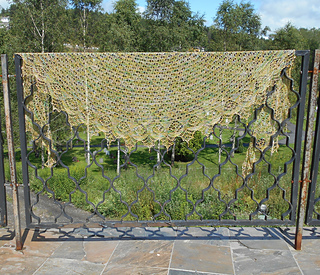patterns >  Reny S Ravelry Store
Reny S Ravelry Store
> Primavera Crescent














Primavera Crescent
Primavera is the Spanish word for spring and I wanted a shallow crescent for those chilly evenings on a warm day in late spring as well as a pattern that knits up quickly, thus Primavera Crescent was born.
The sample, as shown, used 105 gr. and was worked on size US 6, 4 mm circs. The body repeats were worked 12 times; if you do not have that much yardage, you should work 11 repeats of the body.
I used a fingering, Schoppel-Wolle Zauberball®. It runs 420 mtr. / 100 gr. Gauge is of no great importance, just aim for a fabric you like.
The pattern is written and charted and has been tested thorroughly.
Shortly after publishing this pattern I learned, that Jane Araújo, Mawelucky was testing an awesome shawlette of a similar name. It can be found here , please do check it out!
Materials:
• Lace to dk yarn, a total of approx. 80-200 gr. will be sufficient depending on yarn weight and intended size. You can use solids, semisolids and colour-changing.
• A very short length of scrap yarn (6 “, 15 cm).
• yarn needle
• scissors
• stitch marker(s)
• US 4 - 8 - 3,5 - 5 mm circs (pick a needle size, that works best for your chosen yarn, at least 2 sizes larger than the label states), you may use a smaller needle for setup and rows 1 to 4 of the chart/ written instructions.
Skills:
• basic lace knowledge: knit, purl, k2tog, ssk, yo
• basic knowledge of chart reading, if you use them, in ws rows all knits are purled and purls are knit, even the selvedge stitches
• for optional border: knit, purl, k2tog, ssk, yo, pfb, sk2p, one special stitch: sk2p and purl into those 3 stitches
• provisional CO and picking up stitches from selvedge (purlwise)
• BO, different types are possible including picots
Optional beads:
• placing of beads is not included
+++++++++++++++++++++++++++++++
Die Deutsche Version wurde hier getestet:
http://www.ravelry.com/discuss/chloes-crescent-corner/363... , derzeit überarbeite ich sie noch.
Nach Kauf der Anleitung bitte PM an mich, wenn Du diese vorab wünschst, um den 16.07. wird die Deutsche Anleitung automatisch hinzugefügt.
Die Maschenprobe sollte zu einem optisch ansprechenden Ergebnis führen. (17 Maschen, 35 Reihen = 10 cm im Grundmuster)
Benötigtes Material:
• Lacegarn oder dicker, insgesamt 80-200 gr. sind ausreichend, je nach Garnstärke und angestrebter Größe. Du kannst eine Uni-Farbe, leicht gemustertes oder Farbverlaufsgarn verwenden.
• Ein kurzes Stück Hilfsfaden gleicher Stärke (~ 15 cm).
• Nadel zum Fäden verstechen
• Schere
• Maschenmarkierer (bei Bedarf)
• 3,5 - 5 mm Rundstricknadel (wähle eine Nadelstärke, die gut zum Garn passt, in jedem Fall aber deutlich größer als auf der Banderole steht), Du kannst für Setup and Reihen 1 bis 4 der Strickschrift/ beziehungsweise der ausgeschriebenen Anleitung eine dünnere Nadel wählen.
Benötigte Fertigkeiten:
• grundlegende Kenntnisse: rechte Maschen
• grundlegende Kenntnisse im Lesen von Strickschriften, wenn Du diese verwendest, in Rückreihen werden alle rechten Maschen links gestrickt und linke Maschen rechts, auch die Randmaschen.
• provisorischer Anschlag und Maschenaufnahme daraus
• Maschenaufnahme aus der seitlichen Kante mit linken Maschen
• Basiskenntnisse im Lace stricken: re, li, 2 re zus, 2 ü re zus, U
• für die optionale Bordüre: re, li, 2 re zus, 2 ü re zus, U, pfb, sk2p, eine spezielle Stichkombination: sk2p und erneut diese 3 Maschen links abstricken, s. Legende Übersetzung.
• Verschiedene Abkettmethoden sind möglich, inklusive Picots
83955 projects
stashed
151905 times
51021 projects
stashed
36541 times
30793 projects
stashed
23361 times
- First published: June 2017
- Page created: June 15, 2017
- Last updated: May 5, 2018 …
- visits in the last 24 hours
- visitors right now




